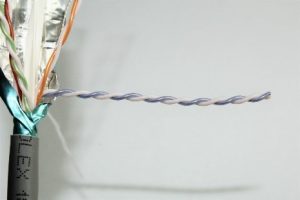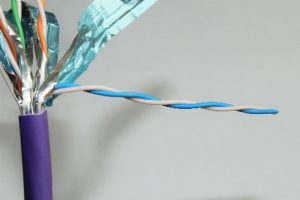What does the combination of letters F/UTP or U/FTP mean? Acronyms are common in the structured cabling world, but what do they mean and what's the difference between them?

F/UTP stands for: foiled, unshielded twisted pair, which in practice means the following - all pairs have a common shielding in the form of foil, but each of the pairs does not have its own shield.

U/FTP stands for: unshielded foiled twisted pair, which means the following - the cable does not have a common shield, but each of the twisted pairs has a foil shield and a common drain conductor.
Are there any advantages of U/FTP cable over F/UTP cable?
Heat!
The choice of cable design has a significant impact on the heat dissipation generated in the cable. The F/UTP cable design provides only one metallized tape around all four pairs, while the U/FTP design provides for a metal tape (foil) around each pair, which allows the heat generated in each pair to dissipate much faster and more efficiently.Better heat dissipation combined with lower DC resistance provides more reliable support for Power over Ethernet (PoE) technology while reducing the potential impact on transmission performance.
Also read: - Data Center Cabling Standards
Long or short?
The twisting length of a pair (cable pitch) is different for F/UTP and U/FTP cables. In cables with the F/UTP design, the cable pitch is different and goes from long to short. This kind of twisting allows you to better deal with crosstalk and interference between pairs. In contrast, the pairs in U/FTP cables have the same twist pitch, since the main element of anti-crosstalk is the shielding of each pair.The long cable spacing and the absence of a pair separator make the U/FTP design unbundling more convenient.
Embroidery
In an F/UTP cable, working with one outer shield can be problematic, as well as the additional step of removing the center divider. While the U/FTP design has 4 shields and allows them to be easily and quickly removed before joining, and the long, even pitch of twisting pairs in such a cable saves time, since it requires less untwisting during the jointing process.
Flexibility
The absence of a center divider in a U/FTP cable usually means that the diameter will be smaller compared to an F/UTP cable. Smaller cables are more flexible, easier to install, have higher tray fill rates, and lower overall conduit and wiring closet stress, which can ultimately improve ventilation and, as a result, lower air conditioning costs.MA student of the TransAtlantic Masters program at UNC-Chapel Hill. Political Science with a focus on European Studies. Expressed ideas are open to revision. He not only covers Technical articles but also has skills in the fields of SEO, graphics, web development and coding. .
Leave a reply
Your email address will not be published. Required fields are marked *Recent post

What is a Data Center and Why is it so Needed?

What Does U/FTP or F/UTP Means and What is the Difference?
